

Abstract
Bad Water Rising is a hydrophobic medium art installation in downtown State College that focuses on Pennsylvania species that are affected by climate change and water quality concerns. These rapid changes make it difficult for certain species to survive and adapt. The art is invisible until it is revealed by the rain, which symbolizes this change. The hydrophobic medium is applied over stencils created by the artist and is entirely invisible on dry concrete. The hydrophobic medium is eco-friendly and biodegradable. This installation is a collaboration between the Hamer Center for Community Design and The Woskob Family Gallery and is also part of the Hamer Center Coffee Hour series “Engaging Water,” and a Woskob Gallery talk “Public Conversation: Artists and Water” featuring artists who work with water in the public realm. The stencils and Story Map are on display during both events.Bad Water Rising is an art installation in downtown State College. Done in a hydrophobic medium—a transparent, paint-like substance that repels water—the installation focuses on local Pennsylvania animal and plant species that are affected by climate change and water quality concerns. According to the EPA:
Rising temperatures and shifting rainfall patterns are likely to increase the intensity of both floods and droughts. Average annual precipitation in Pennsylvania has increased five to ten percent in the last century, and precipitation from extremely heavy storms has increased 70 percent in the Northeast [United States] since 1958 [.…] Rising temperatures will melt snow earlier in spring and increase evaporation, and thereby dry the soil during summer and fall. As a result, changing the climate is likely to intensify flooding during winter and spring, and drought during summer and fall (USEPA 2016).
These changes make it difficult for certain species to survive and adapt, especially since the changes are happening so quickly.
Because the installation is done using hydrophobic medium, it is invisible until it is revealed by the rain, which symbolizes the change. This concealment and revelation is a metaphor for the invisibility of the species and their plight. The stencils were drawn digitally by the artist/researcher, and then laser cut into recycled chipboard.

The hydrophobic medium is entirely invisible on dry concrete, eco-friendly and biodegradable, and lasts two to four months, depending on wear.
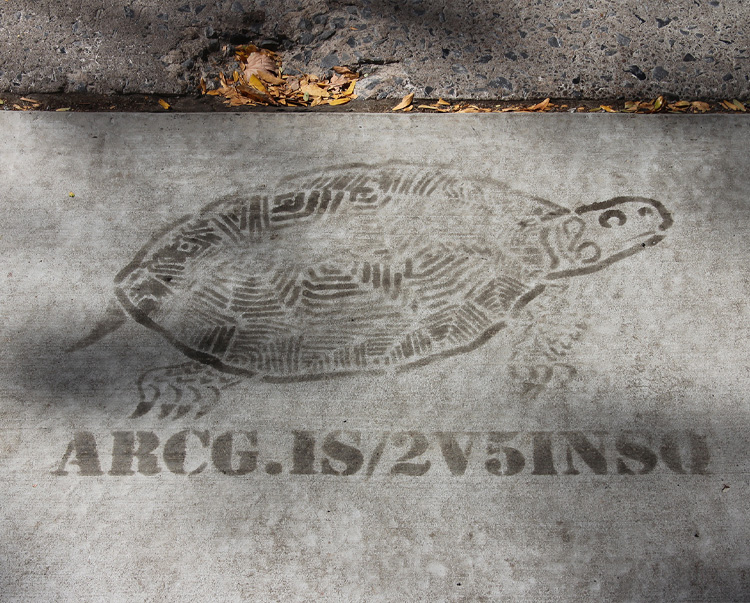
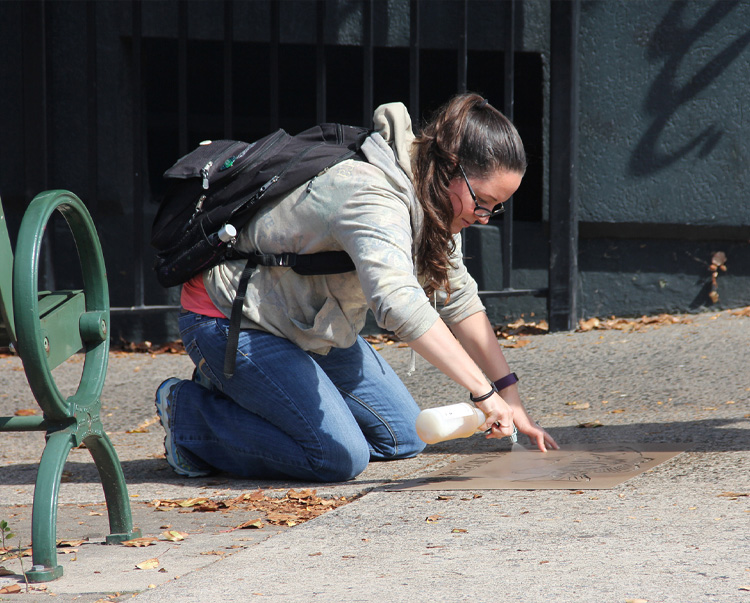
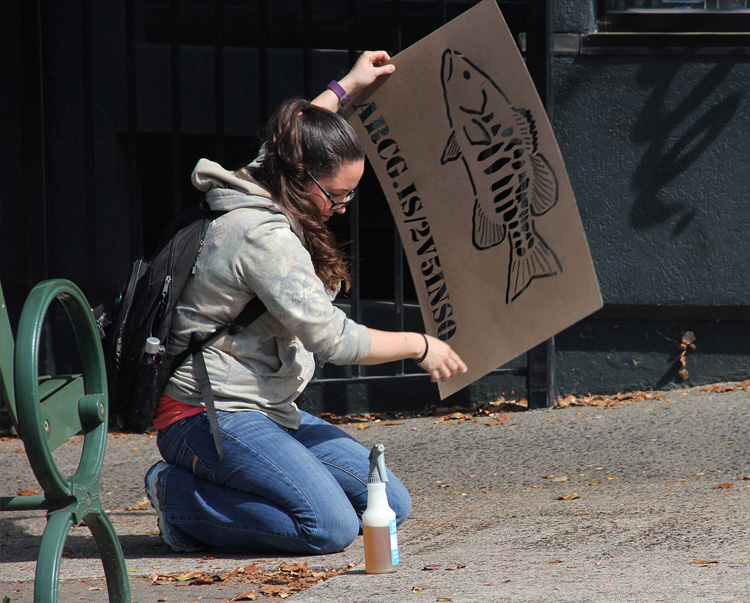
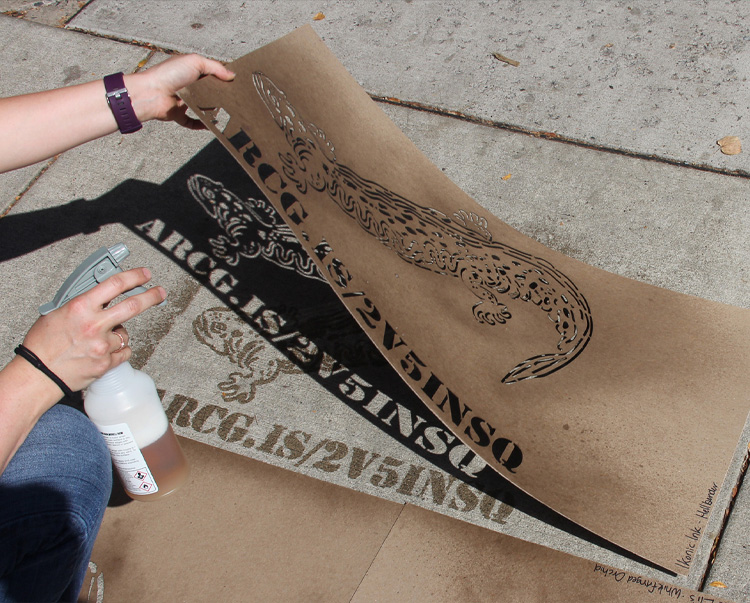
This installation is a collaboration between the Hamer Center for Community Design and The Woskob Family Gallery. It is along the main crossroads of the downtown area of State College (Allen Street and Beaver Avenue) and coincides with the SEEP exhibit at the Woskob Family Gallery.

Additionally, a Story Map shows the locations of the stencils. Each stencil includes a link to the Story Map so viewers can learn more information about the affected species and find and explore other stencil locations. The Story Map and installation locations for this project can be viewed here: http://arcg.is/2v5INsq. Each location represents an individual plant or animal species.

Within the map application, representative images of the specimens are included as a slide show to provide a glimpse of the real plant or animal. These images are all open source from either the Wikimedia Commons or Flickr using Creative Commons license Attribution 2.0 Generic (CC BY 2.0) or Pixnio.com using Creative Commons license (CC0). Once an image or location marker is selected, specific information about the species and its situation (see Union of Concerned Scientists 2008; Furedi et al. 2011; The Pennsylvania Natural Heritage Program 2019) is included in a pop-up menu.
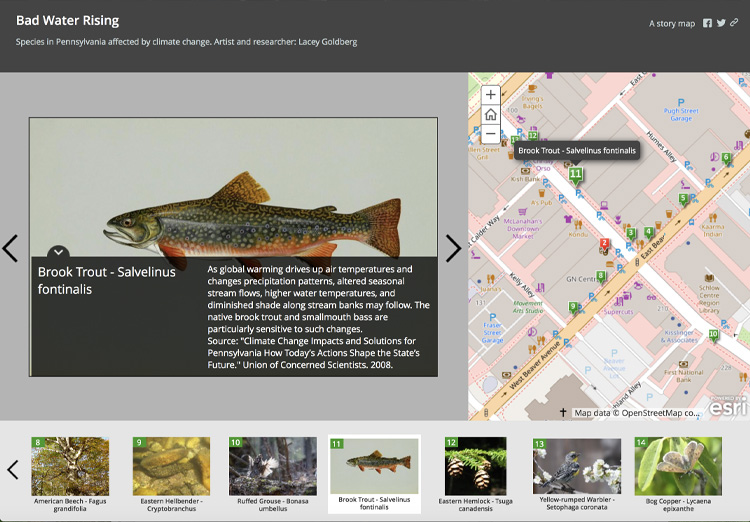
This project is also part of the Hamer Center Coffee Hour series “Engaging Water” in the Hamer Center for Community Design, and the gallery talk “Public Conversation: Artists and Water” in the Woskob Family Gallery featuring a conversation with several artists who work with water in the public realm. The stencils and Story Map are on display during both events. While the stencils will fade within two to four months, the Story Map remains live on the web.
Work Cited
Furedi, Mary Ann, Betsy Leppo, Matt Kowalski, Tony Davis, and Bradley Eichelberger. 2011. Identifying Species in Pennsylvania Potentially Vulnerable to Climate Change. Pittsburgh, PA: Pennsylvania Natural Heritage Program, Western Pennsylvania Conservancy.
The Pennsylvania Natural Heritage Program. 2019. “Conservation Tools.” https://www.naturalheritage.state.pa.us/Resource.aspx.
Union of Concerned Scientists. 2008. Climate Change in Pennsylvania: Impacts and Solutions for the Keystone State. Cambridge, MA: Union of Concerned Scientists.
USEPA (United States Environmental Protection Agency). 2016. What Climate Change Means for Pennsylvania. Government Report, EPA 430-F-16-040. https://19january2017snapshot.epa.gov/sites/production/files/2016-09/documents/climate-change-pa.pdf.
